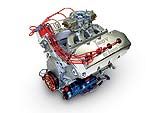
Some guys just have a driving ambition for the one-upmanship and achievement in building "The ultimate" g-Machine. When you consider it, it's a tall order. In the realm of street performance, the goal of the g-Machine has "the ultimate" wrapped up in it by definition. Unsurpassed handling, roadabilty, acceleration and balls-out power are the hallmarks of the g-Machine scene. Attempting to render the ultimate incarnation of the g-Machine is really striving for the ultimate of the ultimate. Bob Johnson is driven towards this goal, and has expressed that ambition through some serious g-Machine project vehicles in the past. His previous efforts have been featured and acknowledged in these pages. (See Bob's '69 Camaro called "Battle Axe," in Jan '04. It was our cover car that month.) Bob's latest endeavor lead to what may be the Holy Grail of the Mopar g-Machine: interpreting Mopar's most desirable musclecar body style, the 'Cuda, as the ultimate g-Machine. Bob teamed up with car builder Alan Johnson (no relation) to craft the concept into reality. The team of Johnson and Johnson were looking towards pushing the envelope far beyond the normal consumer goods, taking their crack at the "The ultimate g-Machine." The finished vehicle will be featured in PHR as an exclusive once it's completed, but those wanting a sneak peak will be able to check it out at the 2005 SEMA show in Las Vegas Starting November 1. Be Forewarned: Don't expect it to be a pampered show car. Bob Johnson's g-Force 'Cuda will be driven hard-hard enough, we expect, to set a new record for a street car going from 0 to 100, and back to 0. That takes a lot of gs (in more ways than one).
Function, form, and most importantly true performance, all integrate into a project this ambitious. Alan's Art Morrison-based chassis will debut with significant engineering, from the custom tube chassis, and one-off all independent coil-over sprung suspension, Baer six-piston disc braking system, massive Michelin PS2 tires, and custom Getrag transaxle. No stone will be left unturned in incorporating the hardware to meet their goals. Of course, topping the list of required machinery for a project of this sort is a suitable powerplant. For this Mopar, Indy Cylinder Heads was the natural choice.
Indy Cylinder Heads (ICH) is a name well known to Mopar fanatics the world over. No one has taken the mantle of Mopar engine performance and gone the distance in the way the organization at ICH has. A milestone for ICH founders Russ and Fred Flagle, was a pioneering move into aftermarket aluminum heads for the Mopar wedge engine introduced decades ago. From this, Indy has grown to design and manufacture Wedge, and Hemi engine components that define contemporary Mopar performance. Indy manufactures blocks, intakes, heads, and many more components that propel the original Mopar engine architecture to power levels, and configurations unheard of back in the original musclecar days.
For the Johnsons' project, the Hemi engine would provide the presence and persona of pure power that would help define the 'Cuda. Hemis are no strangers to power production, but in a g-Machine application the sheer mass of the engine would disturb the delicate balance that the builder was looking to achieve with the vehicle. Here, ICH provides the answer in their aluminum Maxx block. Using the Maxx as the basis for the powerplant opens the door to a near ideal situation. Indy's complete all-aluminum Hemi makes for a lightweight package, tipping the scales at a small-block-like 535 pounds. Low mass is nice, but the powerplant is advantaged further by the sheer strength and capacity possible with the Indy Maxx block. Indy can, and routinely does, build these engines in displacements of 655 plus ci, and the power handling capacity are off the scale. Indy's hardware makes the notion of a lightweight, big inch, high-powered and reliable Mopar engine a reality.
But the high-g nature of Indy's g-Force Hemi doesn't end with lightweight. In order to achieve the ultimate balance for handling, car builder Alan Johnson made the decision to position the Hemi rearward and lower in the engine compartment, thus setting into motion some rather significant design requirements for the engine, body, and drivetrain. Rearward location of the g-Force Hemi meant using the aforementioned Getrag rear transaxle, but it also meant using a dry-sump oiling system. This allows for superior oil scavenging under hard cornering loads, and it also improves the vehicle's center of gravity by allowing the engine to be much lower in the chassis. Yes, it sounds odd, but the Indy g-Force Hemi is an engine that-when integrated properly with the chassis-actually improves handling.
Zeroing in on the exact combination for this project was a collaborative effort with input from the vehicle builder providing the objectives that needed to be met. Making more than a useable amount of power would be no problem based on the resources at Indy, however the Johnsons imposed constraints. The engine would above all need to meet the requirement of real streetabilty. This is defined by the requirements for reliability in long-term street use, a reasonable, if not tame idle quality, and the ability to swill normal pump gasoline without balking (although just barely!). With the massive reserves of power potential in the Indy Legend line of aftermarket Hemis, meeting these goals, while producing unnerving output was the task of Indy's chief engine builder Ken Lazzeri.
Ken took the "conservative" approach, knowing that by scaling back the combo of one of Indy's race-spec'd mills, the drivability, low-maintenance and reliability objectives could be easily met. At the same time, with a relatively large displacement and just enough cam, compression and cylinder head, the output would remain dramatic. Although the engine, with a bore and stroke of 4.50 inches displaces 572 ci, by Indy's standards this is a conservative displacement. In a street application, it would be hard to argue that 572 cubes would fall short of delivering all the torque a car could manage. Low-end torque is what you'd expect, but what comes as a surprise is the high rpm characteristics of this mighty Hemi. Power just keeps coming on, a testimony to the outstanding matching of the combination's components, and the phenomenal flow of Indy's Windjammer CNC-ported heads. The bottom line: what we have here is a 572ci Hemi that weighs-in and revs like a small-block, while belting out more torque and power than most street freaks could imagine. If like Alan and Bob Johnson, you are looking to build up the ultimate, here in detail is what Indy did to make it come together.
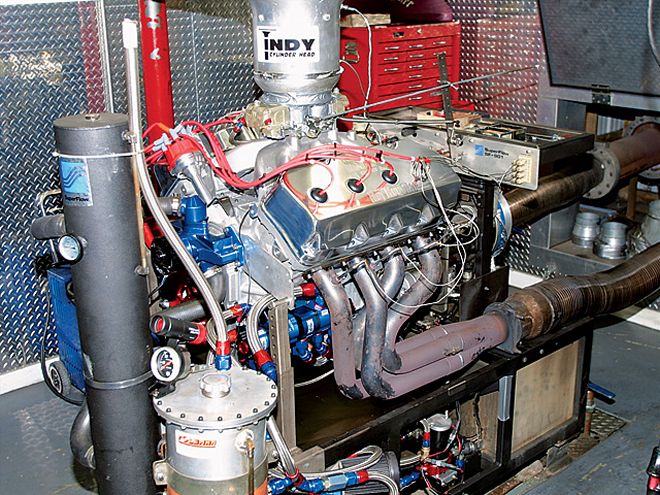
ON THE DYNO
How much power is enough, and just how much can our healthy g-Force Hemi deliver? The owner of the g-Force 'Cuda, Bob Johnson, looked at the extravagant output of the all-aluminum Hemi in an abstract way. Johnson relates, "The 'Cuda is not something we are putting together to conventional standards, not in looks, not in construction, and certainly not in performance. The car will push the limits, and then we'll shoot for a hell of a lot more, and that might just put us where we'd be satisfied." What does it take to be satisfied with the output of this metal warrior's powerplant? Five hundred and twenty pounds of aluminum dynamite, blasting the competition with 870 dyno-verified horsepower and a violent 780 lb-ft of torque should be enough to satisfy the most wanting power junkie's addiction.
Johnson pointed out that power was going to be key to the car's character, "You don't build a machine like this tube-framed terror and come up short on the punch line. You'd dammed well better have something special and it has to have the right power curve to do the job." Indy's chief engine builder Ken Lazzari massaged the combo for just that balance of output with the right curve. Lazzari explains, "Everything was keyed for meeting the goals of good street manners, and a power curve that comes on hard initially, but doesn't let go, pulling huge power up top to where the car will be able to really use it."
Lazzari continues, "We build engines that are significantly larger, but this displacement was selected for balance. We have so much torque down low the chassis guys will have a real job harnessing it at this level, so there isn't a need for more size and bottom-end. These heads at this displacement, with the rest of our combo, just keeps building power as the tach swings up. Get it in a street car and nail it, and you don't have to let go 'til over 7,000 rpm." A high-revving powerband that tastes like a Trans-Am small-block of yesterday, but scaled up to 572 ci of Hemi power, making double the power, and doing it tractably on pump gas. Indy's combo redefines g-Machine power.
DYNO CHARTINDY/PHR g-FORCE 572 HEMI
SUPERFLOW DYNO ACCELERATION TEST (600 RPM/SEC)
TESTED @ INDY CYLINDER HEAD
STP CORRECTION FACTOR
RPMTORQUE HP35006894594000683520450072462150007637275100781*7595500771808600074084565006998656700683871*7000640853* Denotes peak
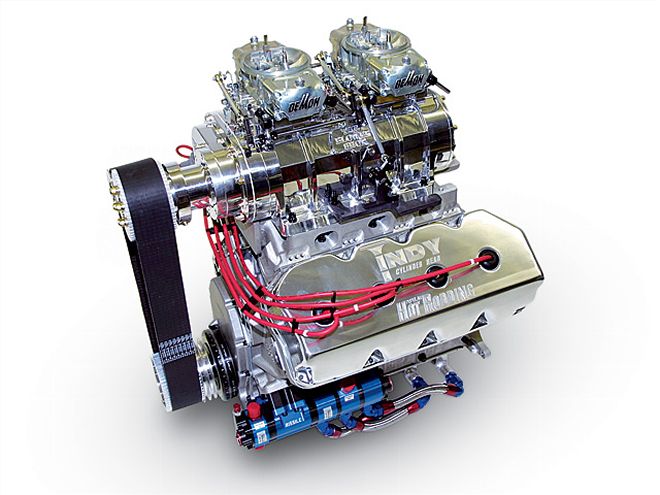
COMBOS TO CONSIDER
Indy's engine-building wizard, Ken Lazzeri, is in an enviable position. If your career is built on creating some of the nation's best engines, then what better home than Indy Cylinder Heads? What's the advantage? The definition of engine builder takes on a new twist at Indy since these guys actually manufacture the major components that make up the engines. Indy literally is in the business of building engines, with their own blocks, heads, intakes and more. Going to Indy for a custom or crate engine is like going to the source-a concept that couldn't be entertained when dealing with OEM factory components and building with an OE engine as a base. These parts are designed at a serious custom engine shop solely for the purpose of building serious custom engines for a variety of applications.
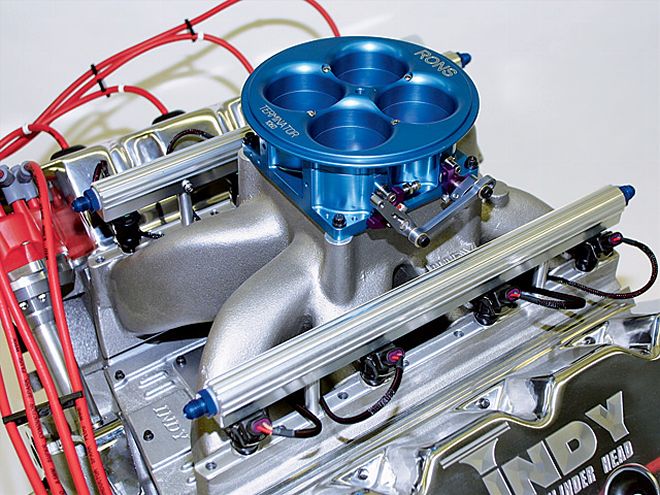
Lazzeri has the grab bag of specialty components at hand to build the right combo for the task at hand. For our g-Force Hemi, the constraints, which drove the selection of components for the build, included the targeted output, fuel requirement, drivability goals, and long-term durability. It helps that Indy has the hardware, and no one knows it better. Ken pointed out that other applications might benefit from other versions of their Legend-series Hemi.
As Ken puts it, "Our Hemi engines tipically displace between 5228-636 cubes with 605 being our most popular combo. We build quite a few 572s, and for this application that was the best choice, but for other applications the larger engines might be the right way to go. Ken notes, "The foundation based on our parts, and the bottom end, can take substantially more power. A blower could add 500 hp to the output of a package similar to this, while an engine with more cam and compression could clear an easy 1,100 hp or more. Other builds may benefit from fuel injection, depending upon the vehicle builder's wants. The street requirements of this build directed us to scale back the cubes, compression, cam, and port volume, basically turning what could be a race engine into a street piece you can drive around. Shrinking the package also works well for endurance, with less loading in aspects critical to engine life, like with valvesprings. This combo may seem like a monster when considering the raw power figures, but in fact, it's under-stressed, and the result is low maintenance and long engine life."
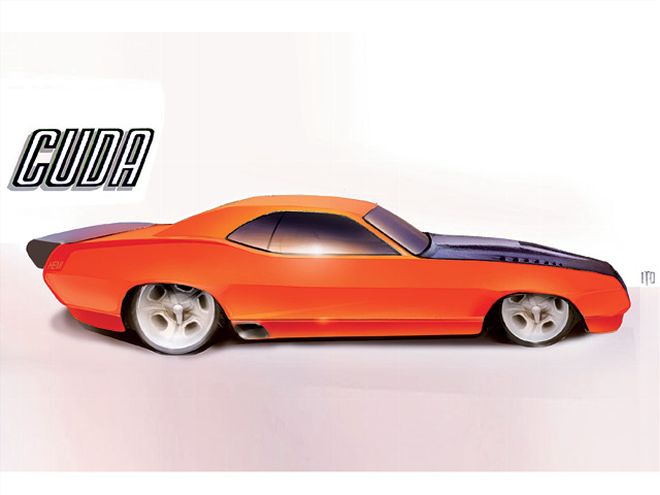
THE g-FORCE 'CUDA: BUILT TO DRIVE
Think all this engine voodoo is just some mental exercise? Think again. This Indy g-Force Hemi is born to run, and run it will. The car the g-Force Hemi will reside in was initially penned by Chris Ito of Ito Concepts (Dallas, Texas) and has some subtle-yet major-changes to the original '70 Cuda shape. Virtually every panel of sheetmetal will be cut, chopped, narrowed or otherwise pounded into submission to create the look for the g-Force 'Cuda. Below the surface, no stone will be left unturned. A set of custom Art Morrison frame rails will be home to a C5 Corvette suspension, and the g-Force Hemi will be set back and lowered for better weight distribution, a flat hood line and suspension clearance. A Getrag transaxle (which we previously and incorrectly identified as a C5 Corvette transaxle) will be housed in the rear for a truly world-class suspension. The finished product will debut at the 2005 SEMA show starting November 1, and PHR will have the exclusive story. After that, the 'Cuda hits the open road-as in "open road racing" and "setting the 0-100-0 world record for a street-legal car." We'll be there when it all happens, so stay tuned!